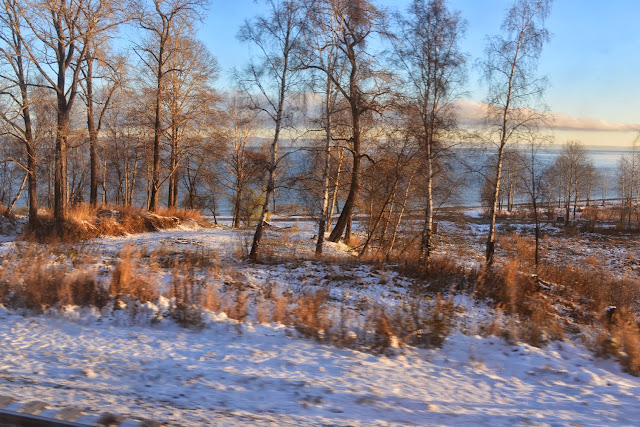Moscow to Ulan Bator (or Ulaanbaatar in local transliteration, or just UB)
After another taxi slog around the clogged Moscow ring road, we
arrived at Yaroslavsky Station in good time for our Train - Number 6, departing
at 21:35 from Moscow to Ulaanbaatar (Ulan Bator), or better abbreviated to UB
as the locals do. Yaroslavsky Station is one of three on Komsomolskaya Square,
not counting the Metro station, so it’s a very busy hub.
The grand Soviet architecture of the main station was hidden
by a lot of building work, so we had to wait for our train in a muddy, icy open
air area. We found a temporary, rickety wooden café nearby which served Russian
fast food and beer, so sheltered therein from the sub-zero temperature until
our train to Улан-Батор
rolled in to Platform Number 3. With all the signs in Cyrillic script,
we had to triple check we were on the right train. The train runs to Moscow
time, so by the time it reaches Ulan Ude (which they also shorten to “UU”) where
it turns south towards UB, it’s 5 hours behind local time, but then UB is the
same as Perth. Very confusing for the body clock, although I guess we can’t
call it “jet lag”?
Train 6 is not a “tourist special” train, so lacks some of
the refinements we soft Westerners take for granted, such as a shower and
en-suite toilet. Despite these drawbacks, our little 1st class compartment
in Car 5 was roomy and comfortable. Each carriage is heated by its own coal
burning boiler, maintained by the carriage attendant. This also drives a
Samovar which provides 24 hour hot water - just the thing for making cups of
tea, and cooking up instant noodles, which became a staple after a couple of
visits to the dining car. Sadly, the dining car food was in tiny portions and
very over-priced, but to compensate, there are old ladies (babushkas) at many
of the stops, selling noodles, beer and in some places freshly cooked food. This
used to be more prevalent, but Moscow has tried to put a stop to it. However,
they have a saying in Siberia that “Moscow is a long way away” and turn a blind
eye to many of these regulations. We bought a nice smoked fish near Lake Baikal,
plus some fish cakes and other goodies to vary the diet.
As we approached and ran along the southern shore of Lake
Baikal, there was plenty of snow around, although this mostly disappeared as we
went further east – however, the temperatures remained very low. Very deceptive
as you sit in your warm carriage, gazing at the sunshine outside, but comes as
a shock when you get off the train. Lake Baikal is enormous, even from the glimpses
seen from the train. It would be great to see in March when frozen, when apparently
you can drive across it. If doing this train trip again and with more time available, it would be much better to stop near Lake Baikal for a few days.
Siberian towns along the track are mostly doing well based on
oil and mineral wealth, although some of the smaller towns are reminiscent of
outback places at home. There is still a lot of grey concrete Soviet
architecture around, although new buildings are mostly in bright colours, which
would be cheery during the white of winter.
The track infrastructure is impressive, at least double, and in many places triple track, all the way from Moscow to Vladivostok, most of it electrified. Heaps of other train traffic, both passenger and freight, with some huge long trains hauling oil tanker cars, logs and cars. For our trip the track got down to single track for the last bit from UU to UB. The border crossings are like the good old days – each side (Russian
and Mongolian) takes about 2 hours for a veritable horde of officials to check everyone
and search the train, so it’s a tedious process. Lucky the Cold War is over, or
it may have been worse.
We arrived at UB about 0645 the next morning – more on UB in
the next blog post.
We tried to capture something of the train journey in
pictures, although taking photos from a moving, rocking, rattling train is not
a recipe for creative artistry. Nonetheless, we did manage a few snaps - below
for your entertainment.








































No comments:
Post a Comment